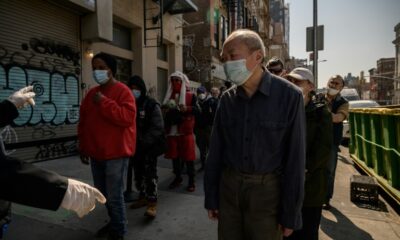Lifestyle
Montreal March Highlights Crisis of Missing Indigenous Women

Montreal witnessed a significant gathering on Saturday as community members marched to honor the memory of missing and murdered Indigenous women and girls. The event was part of a national day of action observed annually on October 4, aimed at addressing the alarming rates of violence faced by this demographic across Canada.
Shirley Pien, a health navigator for an Indigenous-led clinic, frequently visits Cabot Square, a park in downtown Montreal where vulnerable populations often gather. Pien expressed concern about the absence of women she once saw regularly in the area. “In the last few months, there are women we used to see regularly that we don’t see anymore. Nobody knows where they are,” she said, highlighting the urgent need for action regarding their disappearances.
The march was organized by a coalition of local Indigenous groups who believe that all levels of government have failed to act on the recommendations from a 2019 national inquiry. This inquiry, which declared the situation a crisis, identified “persistent and deliberate” human rights violations as central to the violence faced by Indigenous women, girls, and two-spirit people. The inquiry issued 231 calls to justice, yet organizers argue that few have been adequately addressed.
Simone Page, who leads a shelter supporting families searching for their missing loved ones, emphasized the increased risk of sex trafficking faced by unhoused Indigenous women. “Those who frequent the area around Cabot Square are routinely targeted by traffickers,” she noted, explaining that such individuals often approach their victims under the guise of friendship. Page pointed out that areas like hotels catering to medical patients, as well as airports and bus terminals, are also hotspots for trafficking.
Concerns extend to law enforcement responses, with Page observing that police often delay searches for missing persons for 24 to 48 hours after a report is made. “Those first 24 to 48 hours are essential, especially when it comes to trafficking,” she stated, reinforcing the importance of rapid action.
Adding to the conversation, Native Nam, an author and artist from Kitigan Zibi in Quebec’s Outaouais region, voiced skepticism about official statistics on missing Indigenous women. “Activist groups suggest the true numbers could be much more,” she told attendees. “These are not just numbers. These are our daughters, mothers, aunties, and cousins; they are us.”
In a statement released on the same day, the federal ministry for Crown-Indigenous Relations and Northern Affairs reaffirmed its commitment to addressing this national crisis. Ministers, including Rebecca Alty and Mandy Gull-Masty, acknowledged the critical role of Indigenous communities in leading local initiatives. They highlighted funding commitments aimed at enhancing community safety, such as the $8.5 million allocated in August for transitional housing for Métis women and children in St. Andrews, Manitoba.
The government has also convened various gatherings involving Indigenous leaders and federal representatives to discuss strategies for tackling the crisis. They have established a national action plan to combat gender-based violence and appointed a chief adviser to focus on human trafficking within the country.
As the march concluded, participants remained hopeful that their voices would be heard. The gathering was not only a remembrance of those who have gone missing but also a call to action for meaningful change. The ongoing efforts to address these issues reflect a growing awareness and urgency regarding the plight of Indigenous women and girls in Canada.
This report by The Canadian Press was first published on October 4, 2025.
-

 Lifestyle1 month ago
Lifestyle1 month agoWinnipeg Celebrates Culinary Creativity During Le Burger Week 2025
-

 Health2 months ago
Health2 months agoMontreal’s Groupe Marcelle Leads Canadian Cosmetic Industry Growth
-

 Science2 months ago
Science2 months agoMicrosoft Confirms U.S. Law Overrules Canadian Data Sovereignty
-

 Education2 months ago
Education2 months agoRed River College Launches New Programs to Address Industry Needs
-

 Technology2 months ago
Technology2 months agoDragon Ball: Sparking! Zero Launching on Switch and Switch 2 This November
-

 Science2 months ago
Science2 months agoTech Innovator Amandipp Singh Transforms Hiring for Disabled
-

 Technology2 months ago
Technology2 months agoGoogle Pixel 10 Pro Fold Specs Unveiled Ahead of Launch
-

 Science2 months ago
Science2 months agoChina’s Wukong Spacesuit Sets New Standard for AI in Space
-

 Technology2 months ago
Technology2 months agoWorld of Warcraft Players Buzz Over 19-Quest Bee Challenge
-

 Business2 months ago
Business2 months agoDawson City Residents Rally Around Buy Canadian Movement
-

 Science2 months ago
Science2 months agoXi Labs Innovates with New AI Operating System Set for 2025 Launch
-

 Business2 months ago
Business2 months agoNew Estimates Reveal ChatGPT-5 Energy Use Could Soar
-

 Technology2 months ago
Technology2 months agoInnovative 140W GaN Travel Adapter Combines Power and Convenience
-

 Technology2 months ago
Technology2 months agoFuture Entertainment Launches DDoD with Gameplay Trailer Showcase
-

 Technology2 months ago
Technology2 months agoGlobal Launch of Ragnarok M: Classic Set for September 3, 2025
-

 Education2 months ago
Education2 months agoAlberta Teachers’ Strike: Potential Impacts on Students and Families
-

 Technology2 months ago
Technology2 months agoNew IDR01 Smart Ring Offers Advanced Sports Tracking for $169
-

 Technology2 months ago
Technology2 months agoArsanesia Unveils Smith’s Chronicles with Steam Page and Trailer
-

 Technology2 months ago
Technology2 months agoHumanoid Robots Compete in Hilarious Debut Games in Beijing
-

 Science2 months ago
Science2 months agoNew Precision Approach to Treating Depression Tailors Care to Patients
-

 Health2 months ago
Health2 months agoGiant Boba and Unique Treats Take Center Stage at Ottawa’s Newest Bubble Tea Shop
-

 Technology2 months ago
Technology2 months agoQuoted Tech Launches Back-to-School Discounts on PCs
-

 Business2 months ago
Business2 months agoBNA Brewing to Open New Bowling Alley in Downtown Penticton
-

 Technology2 months ago
Technology2 months agoDiscover the Relaxing Charm of Tiny Bookshop: A Cozy Gaming Escape










